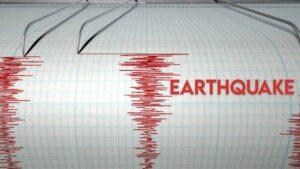Authorities continue to monitor the situation to ensure the safety of aviation and coastal regions along their projected trajectory.
A satellite image shows ash rising from the eruption of the Hayli Gubbi volcano in Ethiopia as it floats over the Red Sea. PHOTO: NASA/Handout via REUTERS
Pakistan’s Meteorological Department has clarified that no threats beyond dangers to aviation have been identified after an ash cloud from a rare volcanic eruption in northeastern Ethiopia moved towards southern Pakistan after passing over Yemen and Oman.
According to the Toulouse Volcanic Ash Advisory Center (VAAC), the cloud originated from the Hayli Gubbi volcano, which erupted on Sunday for the first time in almost 12,000 years. The eruption sent huge plumes of smoke into the atmosphere, leaving large areas of the region in darkness.
In response, the PMD has issued an aviation surveillance alert. Domestic flights, which typically operate at about 35,000 feet, and international flights, which fly between 40,000 and 45,000 feet, may face engine hazards from the ash cloud. Authorities are actively monitoring their movements.
The VAAC reported that the ash column reached extreme altitudes, affecting the airspace over southern Saudi Arabia, Yemen, Oman and the coastal regions of Pakistan. However, the PMD stated that Karachi is unlikely to experience any direct impact. “Projections indicate that the ash will move mainly over the deep Arabian Sea, Oman and the Mumbai flyover region at around 50,000 feet,” a spokesperson said.
Earlier in the day, the cloud was detected 60 nautical miles south of Gwadar, prompting an active warning to be issued to relevant authorities. PMD spokesperson Anjum Nazeer Zaighum confirmed that the ash would stay away from the coast as it moved over the Arabian Sea.
BREAKING: Significant eruption reported in Afar, Ethiopia 🌋
Urgent reports this morning indicate a major volcanic explosion in the Afar region, either at Ali Bagu (Amaytole) or possibly Erta Ale itself. Preliminary information suggests that the eruption may be located between… pic.twitter.com/ChwmyT9vDZ
— Volcaholic 🌋 (@volcaholic1) November 23, 2025
Eyewitnesses in the Afar region of Ethiopia described the eruption as extraordinarily powerful. A local resident said The Addis Ababa Standard that the explosion occurred eight kilometers from the main mountain of the volcano. distant television reported a “massive eruption,” noting that the force and sound of the explosion was louder than any previous event remembered by residents. Reports indicated that the sound and effects were felt as far away as Djibouti, Tigray and towns in the Wollo area.
The FlightRadar flight tracking platform showed the projected trajectory of the ash cloud at 3:31 a.m., heading toward the Arabian Peninsula and the Arabian Sea. Pakistan is directly in the path of the cloud and is expected to arrive in approximately 18 hours. VAAC interactive mapping indicates that the ash could pass over southern Sindh before moving northeast towards India.
The Hayli Gubbi volcano, located in the Ethiopian region of Afar, about 800 kilometers northeast of Addis Ababa, near the border with Eritrea, erupted for several hours. With a height of approximately 500 meters, the volcano lies within the geologically active Rift Valley, where two tectonic plates meet.
The Smithsonian Institution’s Global Volcanism Program confirmed that Hayli Gubbi had no recorded eruptions during the Holocene epoch, which began about 12,000 years ago. Volcanologist Simon Carn, professor at Michigan Technological University, corroborated the finding by stating that the volcano “has no record of Holocene eruptions.”
Authorities continue to closely monitor the ash cloud to ensure the safety of aviation and coastal regions along its projected path.




